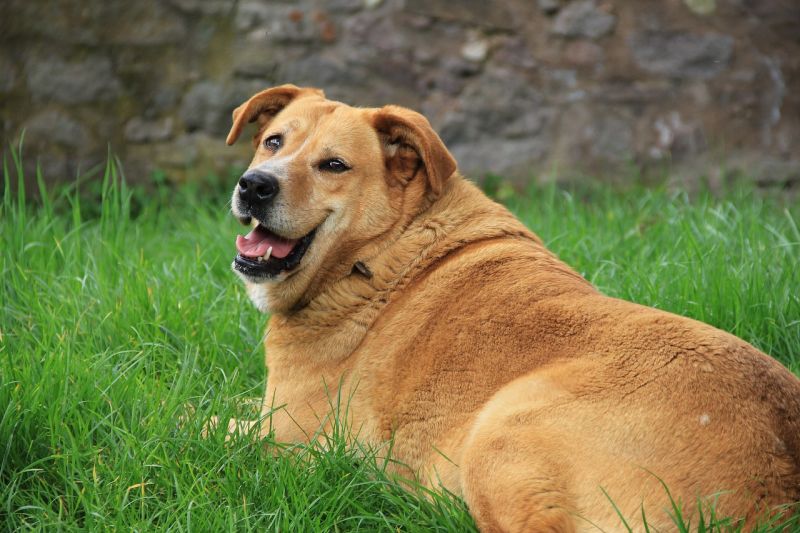Hip dysplasia is an orthopedic condition that can occur in any breed, and unfortunately, treating it isn’t easy. Some dogs require surgery to correct the issue and improve their quality of life. This can — as you might expect — be expensive.
Generally, hip dysplasia surgery in dogs costs between $800 and $6,000 per hip, depending on the type of surgery required and a litany of other factors.
We’ll discuss hip dysplasia, the costs of different types of hip dysplasia surgeries, and explain the other treatments available (including surgical and non-surgical options) below.
Key Takeaways: How Much Does Hip Dysplasia Surgery Cost?
- Hip dysplasia is a problem that occurs when a dog’s hip joint fails to form properly. Though the condition varies in severity, it often causes dogs quite a bit of pain, limits their mobility, and reduces their quality of life.
- There are a variety of treatments for hip dysplasia, ranging from medication to surgery. You’ll have to speak with your vet to determine the best course of treatment for your pet, but mild cases are sometimes treatable with medications and lifestyle adjustments, while severe cases often require surgery.
- The cost of hip dysplasia surgery varies, but it typically ranges between $800 and $6,000 per hip. The costs vary based on the type of hip surgery performed and the overall health of your pet.
What Is Dog Hip Dysplasia?

Hip dysplasia is the malformation of a dog’s hip joint.
Rather than gliding smoothly like the ball-and-socket joint should, the hip bones of dogs with dysplasia grind against each other. Over time, this wears on the joint, causing significant joint pain, bone erosion, and ultimately loss of movement.
Sadly, some dogs and owners get a double-dose of bad news, as hip dysplasia can affect one or both hips.
Your vet may diagnose the condition in puppyhood or you may notice symptoms on your own as your pup ages. In almost all cases, some type of treatment is required, as the condition greatly impacts your dog’s quality of life, affecting everything from him getting out of bed to pottying properly.
Which Dogs Are at Risk of Hip Dysplasia?
Hip dysplasia is mainly a hereditary condition, but growth problems, excessive exercise, and improper nutrition can increase a dog’s likelihood of suffering from the condition. Certain breeds are also at a greater risk of the ailment.
Most commonly, dogs who suffer from hip dysplasia fall into one or more of three basic risk groups:
Hip Dysplasia Risk #1: Dogs Who Are Overweight

Extra weight puts unnecessary stress on a dog’s joints. And while excessive bodyweight can cause problems for just about any four-footer, it can be especially hard on dogs who’re predisposed to hip dysplasia.
Indeed, carrying a few extra pounds can be disastrous for pups predisposed to the condition. With the joint’s structure already compromised because of dysplasia, the wear-and-tear caused by the extra weight can accelerate the breakdown of bone and appearance of pain.
Hip Dysplasia Risk #2: Dogs Who’re Members of a High-Risk Breed

While any individual doggo can suffer from hip dysplasia, members of some breeds are more likely to develop the condition than others. Large and giant breeds are common sufferers, as are smaller breeds with more extreme builds.
A few of the breeds most susceptible to hip dysplasia include:
- Labrador retriever
- Golden retriever
- Rottweiler
- Old English sheepdog
- German shepherd
- English bulldog
- Great Dane
- Pug
- Neapolitan mastiff
- Saint Bernard
- English mastiff
- French bulldog
It’s important to note that while hip dysplasia is more common in these breeds, not every dog will wind up with the ailment.
One more thing: Mutts are also at risk of hip dysplasia. It’s just something to watch for, as you would with any other common genetic condition. Of course, it may be worth investigating your dog’s DNA to find out if any of the breeds in his family tree often suffer from the condition.
Hip Dysplasia Risk #3: Dogs Whose Parents Have the Disease

Since hip dysplasia is often hereditary, dogs with parents who suffered from hip dysplasia are more likely to develop it themselves someday.
Ethical breeders strive to weed hip issues out of their breeding lines through careful hip evaluations. Also referred to as hip scores, these exams are performed by the Orthopedic Foundation of Animals (OFA). If a dog does not score well, he or she isn’t including in breeding programs.
This genetic factor makes selecting the right breeder of the utmost importance if you’re interested in an at-risk breed or a big breed in general. Ask what testing they’ve had performed on their dogs, including hip and elbow scores. Reputable breeders of large, giant, and at-risk breeds will have them done regularly and make them available upon request.
What Are the Symptoms of Hip Dysplasia in Dogs?
The onset of hip dysplasia and its signs vary by dog. Some canines show symptoms in puppyhood while others don’t have issues until they’re older. This makes regular vet appointments a must as your doggo ages.
The most common symptoms of hip dysplasia are:
- Discomfort or hesitancy during exercise
- Rising slowly or laboriously from a lying position
- Poor range of motion in hind legs
- Stiffened rear legs while walking
- Loss of rear leg muscle tone
- Hind leg lameness
- Running or walking in a distinct “bunny hopping” fashion
- Difficulty or hesitation climbing stairs
What Are the Basic Treatment Options for Hip Dysplasia?
The best treatment for hip dysplasia depends on the individual case, as some dogs need more intervention than others.
Your veterinarian will assess your dog’s condition, which will likely involve a physical exam, X-rays, and blood tests to determine the best course of action for his situation. There are a number of treatments that may be prescribed based on the dysplasia’s severity, your dog’s age, and your dog’s size, which we’ll detail below.
Medications
Medications are often a first-line treatment for dogs suffering from hip dysplasia.
Some, such as carprofen and other non-steroidal anti-inflammatory drugs (NSAIDs), work by reducing the painful inflammation caused by the joint grinding against itself. These may be given on their own to help manage hip dysplasia symptoms or they may be used with other treatments, like surgery. Just note that many of these drugs necessitate regular blood analysis to test your dog’s liver function, as they can affect your dog’s organs over time.
Other types of pain medications, such as gabapentin or amantadine, are often used to combat moderate-to-severe pain. But while these types of medications are effective in making your dog more comfortable, they don’t address the inflammation or treat the root cause of the pain like some NSAIDs do.
In particularly severe cases, opioid medications may be prescribed to help relieve your dog’s hip pain. However, many vets try to avoid prescribing these types of drugs unless absolutely necessary, as they can cause dependency and unpleasant side effects, such as constipation.

Supplements
Many of us give joint supplements to our fur buddies as they age to support joints and bones, but for pups with hip dysplasia and other orthopedic conditions, these are especially important.
Joint supplements are generally used along with other treatments for hip dysplasia, as they help nurture joint health over time, but they aren’t cures or fast-acting boosters. They are available in many forms, including tasty chewables, liquids, and powders, they rely on several different active ingredients, and they come in several price ranges.
A few of the most common joint-supporting supplements you may want to consider include:
- Chondroitin and glucosamine — two substances that work in conjunction to support cartilage (the cushion between bones that can be worn away as the hip socket grinds against itself) — are some of the most common ingredients included in joint supplements.
- Omega-3s are also helpful for reducing joint pain in some cases. Found in fish oil and green-lipped mussels, these fatty acids help reduce inflammation, and they may also help with coat and brain health.
- Methylsulfonylmethane or MSM is another over-the-counter supplement option with anti-inflammatory principles that your vet may recommend. It comes in a capsule or powder form.
- Your pup might also find pain relief with cannabidiol (CBD). Relatively new on the scene, CBD oils and treats may help ease joint pain due to hip dysplasia.
Before offering any supplement, contact your veterinarian to make sure they’ll help rather than hurt your pup, as they can interfere with some medical conditions or existing medications.
It’s also important not to mix and mingle supplements since they aren’t always compatible. And, as always, check with your vet before initiating a supplement regimen.
Surgery
Unfortunately, medications and supplements won’t always work for dogs with hip dysplasia, leaving surgery as the only remaining option.
There are several surgical interventions used to treat hip dysplasia. When each is used depends on the pup patient’s age and overall condition, with more severe disease needing more aggressive surgery.
Surgery is most often recommended when hip dysplasia is severe enough to cause ongoing pain. It’s the most expensive treatment upfront, but over time, medications and other options add up and may exceed some surgical option costs.
How Much Does Hip Dysplasia Surgery Cost?

Like many canine procedures, hip dysplasia surgery isn’t cheap. And because there are several different types of hip dysplasia surgery, the costs vary pretty significantly.
Unfortunately, this isn’t an area in which you can just pick the cheapest canine hip dysplasia surgery, either. The efficacy of the surgeries vary from one approach to the next, and some dogs are better candidates for different types of surgeries than others.
We’ll dive into some of the specific types of hip dysplasia surgery and explain the associated costs below.
Just note that the costs discussed only account for the surgery itself and not the preoperative diagnostics or potential postoperative therapies. Your vet will discuss your dog’s status with you, and together, you can determine which would work best for you.
Juvenile Pubic Symphysiodesis

As the name implies, juvenile pubic symphysiodesis (JPS) is performed on puppies rather than adult dogs. It’s less invasive than other surgical options and can prevent the need for far more expensive surgeries, like total hip replacement as the joint deteriorates.
During the surgery, your vet will scar the growth plate at the bottom of the pelvis. This causes the growth plate to close prematurely, thereby allowing for proper joint formation and function as your pup grows. While it sounds painful, this surgery has a far shorter recovery time and causes less pain than other options.
For best results, a puppy should be between 14 and 16 weeks old when JPS is performed. It can be done up to 20 weeks, but as the hips firm and your dog grows, it becomes less effective. Pricing for this type of hip dysplasia surgery starts at around $800 per hip.
Pelvic Osteotomy (Double or Triple)

Also called DPO or TPO, pelvic osteotomy involves cutting into two or three pelvic bones (hence the terms “double” or “triple”) to improve joint flow and function.
Then, a bone plate is added to the pelvis to provide stabilization. This may sound scary, but it will actually help your dog’s hip move correctly. This should help reduce the pain and immobility dysplasia often causes.
Both double and triple pelvic osteotomies are performed on medium or large breed dogs who’re 10 months of age or less. Unfortunately, dogs already suffering from arthritis are not candidates for the procedure.
Pricing for double or triple pelvic osteotomies varies significantly, but it generally ranges from $1800 to over $4000 per hip.
Femoral Head Ostectomy

A femoral head ostectomy (FHO) involves the removal of the ball of the femur. This allows the body to create a false socket and some scar tissue. Over time, this will essentially create a new hip joint.
This is obviously a pretty drastic surgical solution, but it should allow your dog to enjoy a much better quality of life than he would with his original hip joint. Fortunately, the price for this surgery isn’t as high as it is for some other approaches, and it usually costs between $1000 to $2500 per hip. However, the ultimate cost will depend on your dog’s size, your location, and other factors.
FHO is usually performed on smaller dogs, and typically isn’t recommended for those above 50 pounds, though rare exceptions exist. Also, a femoral head ostectomy isn’t the ideal option for dogs who’re overweight or inactive.
Total Hip Replacement

A total hip replacement (THR) completely replaces the hip joint (including the ball of the femur and the hip socket) using titanium and plastic implants. This, when successful, allows for restored movement without pain.
This surgery is often regarded as the best option for dogs with hip dysplasia, but it comes with a steep price tag. The surgery alone can cost upwards of $6000 per hip, and that doesn’t include preoperative consults, bloodwork, or other fees you may incur during treatment.
Total hip replacement is usually the surgery of choice for dogs suffering from severe hip dysplasia, since it is the most effective. But given that it’s a very involved procedure, potential candidates must undergo a series of tests over several appointments to ensure it’s the right treatment option for them.
Understandably, many owners are eager to avoid hip dysplasia surgery when possible. No matter what tax bracket you’re in, a multi-thousand dollar surgery is no small matter.
There are a few non-surgical treatment options available, but it’s important to understand that they’re not always cheaper than surgical solutions.
For example, while using medicines to treat your dog’s hip dysplasia may sound better than plunking down $2000 or more for a surgical option, medicinal treatments may cost just as much, if not more than surgery over the long run.
Can You Save Money on Hip Dysplasia Surgery for Dogs?
While hip dysplasia surgery is expensive, there are a few ways to mitigate the costs.
For one, pet insurance may cover a portion or all of the surgery, depending on your plan. You can also look into payment plans with your vet or seek third-party options, like Care Credit.
It may also be worthwhile to call around to a number of different veterinary offices so you can compare prices. However, because you may need a specialist, this isn’t always easy, and you may have relatively few veterinarians to choose from in your area.
Don’t forget to consider veterinary schools, either — sometimes they offer services at reduced costs.
However, the best possible way to save money on dog hip dysplasia surgery is by avoiding the need for it in the first place.

We’ll discuss a few of the most effective ways to avoid the need for hip dysplasia surgery below.
How to Reduce the Chances of Your Dog Needing Surgery
While nothing can 100 percent guarantee success in every case, you can reduce your dog’s risk of needing dysplasia surgery during his life by following a few careful steps, including:
- Only buy dogs who’ve been carefully screened: If you’re buying a pup from a breeder, make sure the breeder performs hip screenings on all breeding stock for large, giant, and at-risk breeds.
- Keep your dog’s weight in check: Avoid overfeeding and keep your pup at a healthy weight to avoid unnecessary stress on his joints.
- Visit the vet regularly for hands-on examinations: Regular exams can pick up on early signs of hip dysplasia (especially in puppyhood), allowing for earlier and cheaper intervention.
- Watch for the first signs of hip dysplasia: Keep an eye out for any change in gait or behavior, such as reluctance to play or run or clear signs of hip tenderness. In most cases, early intervention will be cheaper than treating hip dysplasia once a significant amount of damage has occurred.
- Feed a quality food: Pick a dog food that meets the AAFCO standards for your dog’s life stage. Also, use extreme caution with homemade diets, as they rarely feature the proper mineral ratios, which can increase the likelihood of a dog developing joint problems.
- Feed your large breed puppy the appropriate food: Got a big breed puppy? Be sure to select a high-quality food specifically designed for large breed puppies and offer it for as long as your vet recommends to ensure proper growth and joint support.
- Avoid excessive exercise: Don’t overstress your dog’s joints, especially in puppyhood. Stick to low-impact exercises when possible, such as swimming.
- Prevent your dog from jumping up and down: It can be hard, but try to keep your dog from jumping on and off high surfaces like couches or beds. This is rough on joints and may worsen an already compromised socket.
Additional Dog Hip Dysplasia Management Options

These are other day-to-day steps you can take to help your pooch, such as guiding him to a healthy weight through diet.
Your vet can assist with selecting the right food or portion size, but you can also swap your dog’s favorite high-calorie treat for other picks like green beans. Excess weight severely impacts your dog’s already compromised joint, and reducing it is the key to helping him live a longer, healthier, more comfortable life.
You can also help strengthen your dog’s muscles through low-impact exercise or therapies. Strengthening his muscles can help support the ailing hip, though you’ll need to work with your vet to select exercises that won’t cause him pain. Swimming, for example, is far easier on joints than running or walking, and the water may help loosen his muscles and relieve pain. Some vets also offer hydrotherapy, where your pooch walks on an underwater treadmill or flat surface.
You can also make your home more dog friendly and accessible, too.
For example, you may place dog ramps on the stairs in your home or leading into the car. There are a number of purpose-built canine ramps on the market, but you can also make a DIY dog ramp yourself.
Ramps will not only make it easier for your dog to access his favorite places (like that one particular corner of the couch he likes so much), but they’ll also help reduce the wear and tear on his joints too.
Placing area rugs on hardwood floors and providing a dog bed designed for dogs with hip dysplasia with a non-slip bottom can also incredibly helpful strategies.

Finally, investing in a lift harness or haunch harness isn’t a bad idea either, as it allows you to assist your dog moving from point A to B.
***
Hip dysplasia is a formidable condition, but with the right treatment, your dog can enjoy a better quality of life. Has your dog undergone hip dysplasia surgery? Which one? Let us know in the comments.









No Comments